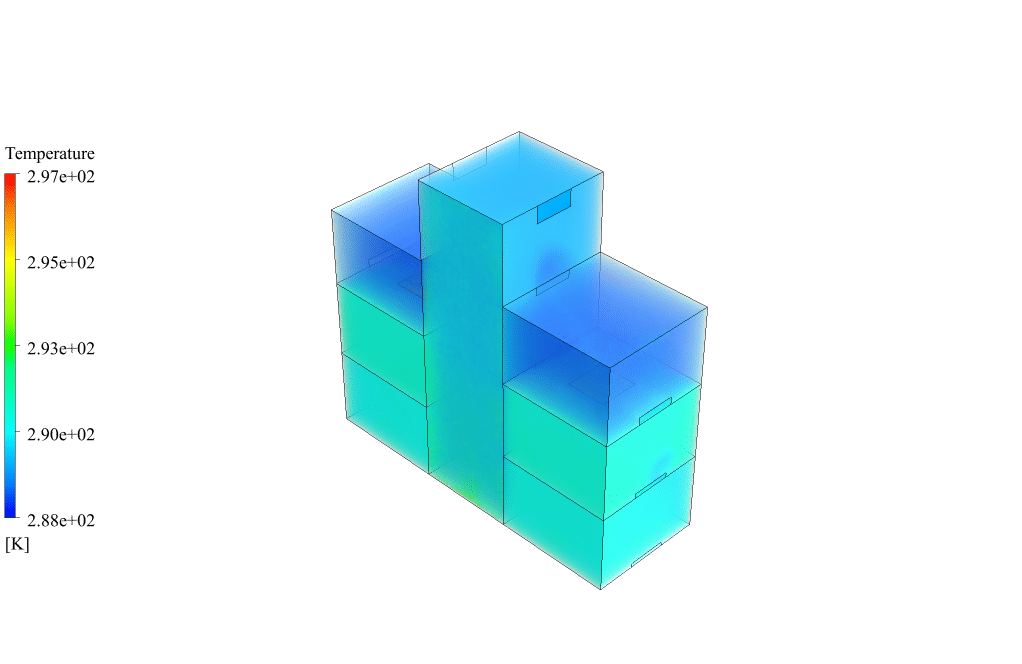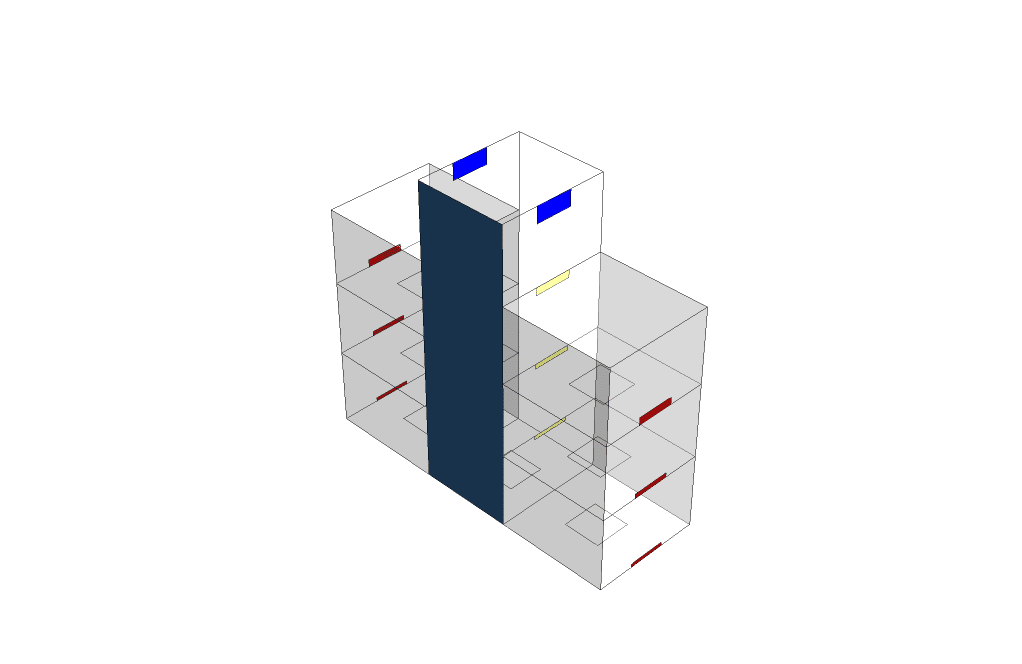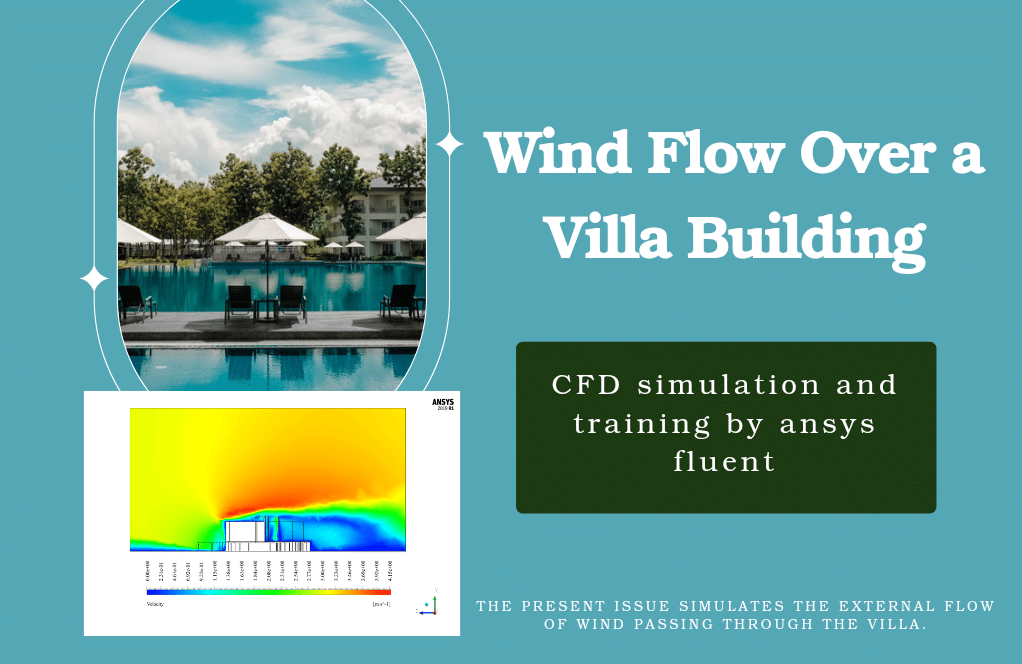DTRM Radiation Model, Atrium Natural Ventilation
$120.00 $60.00 Student Discount
- The problem numerically simulates Natural Ventilation in Atrium using ANSYS Fluent software.
- We design the 3-D model with the Design Modeler software.
- We mesh the model with ANSYS Meshing software, and the element number equals 709511.
- We use the Discrete Transfer Radiation Model (DTRM) to define radiation heat transfer.
- We use Solar Ray Tracing to apply the effect of solar irradiation.
To Order Your Project or benefit from a CFD consultation, contact our experts via email (info@mr-cfd.com), online support tab, or WhatsApp at +44 7443 197273.
There are some Free Products to check our service quality.
If you want the training video in another language instead of English, ask it via info@mr-cfd.com after you buy the product.
Description
Natural Ventilation in Atrium, Radiation, DTRM, CFD Simulation, ANSYS Fluent, Training
Description
In this project, we perform the numerical simulation of natural ventilation inside an atrium building considering DTRM radiation heat transfer using ANSYS Fluent software. The model of the current project is related to the interior space of a simple atrium building, which has three stories of rooms on two sides.
There is an airflow inlet in the lower part of each room on different stories. Also, on the wall opposite the entrances, there is a panel for air exits.
This outgoing airflow from each story moves upward in the central part of the atrium building. Finally, this air exits the final outlet panel at the highest point of the atrium. Inside the central atrium building and each room are various heat sources (including thermal, electrical equipment, etc.). Also, the exterior of the building is designed as glass and is directly exposed to the sun.
Thermal energy can be transferred by conduction and convection methods. However, it is assumed that radiation heat transfer also occurs in this project. This project aims to investigate the effect of heat transfer in different ways and the effect of solar radiation on natural air conditioning.
We designed the geometry of the model in 3D using Design Modeler software. The computational domain of the model is related to the interior space of a simple atrium building. This building has a central part and two three-story buildings on both sides. Each of these stories has an entrance and exit. Then we meshed the model using ANYS Meshing software. The meshing is unstructured, and 709511 cells are generated.
DTRM Methodology
For this simulation, we used the radiation model to define radiation rays. Radiation heat transfer is one of the methods of heat transfer (such as conduction and convection). All materials at a specific temperature release heat from themselves to the environment, called radiation heat transfer. Radiation heat transfer is used in cases such as flame with a significant environmental temperature.
There are different methods for the radiation model in ANSYS Fluent software. We use the Discrete Transfer Radiation Model (DTRM) in this project. The primary assumption of the DTRM is that the radiation leaving the surface element in a certain range of solid angles can be approximated by a single ray.
Also, we used Solar Ray Tracing to apply the effect of solar radiation on the model. It is enough to determine the data about solar radiation for the model. The current model is related to the building in the southwest direction located in Montreal city in Canada, and is examined at 13:00 on July 15.
These input data determine the amount of direct and diffuse irradiation and the direction of solar rays.
DTRM Conclusion
After the conclusion, we obtained the contours related to temperature, pressure, velocity, and density. We also presented velocity vectors. The results show that the air inside the rooms is heated by heat sources defined on the floor of each story.
However, the natural ventilation system in the atrium building causes the air to leave the exit part of each story and be transferred to the central part of the atrium. Then this air leaves the upper part of the atrium building. This causes the proper circulation of the airflow inside the building.
This CFD Project is the 4th episode of the Radiation Model Training Course.
















Raina Haley DVM –
I just finished this CFD Project from MR CFD and must say I’m thoroughly impressed! The DTRM radiation model was clearly explained and the incorporation of solar ray tracing aligned perfectly with the simulation objectives. It was particularly fascinating to observe the effect of natural ventilation boosted by solar radiation. The complexities of natural venting in structures, complete with intricate geometries and shifting heat sources, were articulated in such an astounding manner. The training aided my understanding significantly.
MR CFD Support –
We’re genuinely delighted to hear about your positive experience with our DTRM Radiation Model – Atrium Natural Ventilation simulation project. Thank you for taking the time to provide such kind feedback. At MR CFD, we strive to offer clear, detailed, and applicable learning materials that enable our users to understand and employ complex CFD concepts effectively in real-world scenarios. We are glad to know it has been beneficial for your learning and understanding. Your engagement and success with our products encourage us to keep delivering high-quality CFD learning resources. Thank you for choosing MR CFD!
Tyreek Bauch –
The description of your DTRM model and the atrium natural ventilation simulation was very informative. Just amazing work on analyzing the heat transfer and ventilation processes so profoundly. The conclusion really helps understand the effectiveness of the design in achieving proper circulation and thermal comfort within the building.
MR CFD Support –
Thank you very much for your kind words! We are delighted to hear that you found the simulation informative and comprehensive. It’s always a pleasure to provide insights that help our customers understand complex systems like natural ventilation in atriums. Your satisfaction with the results of our CFD Project and our Radiation Model Training Course means a lot to us. If you have any more questions or need further assistance, don’t hesitate to reach out!
Trisha Gaylord –
I’m thrilled with how detailed the simulation process for the atrium natural ventilation project is. The attention to the specifics of DTRM radiation models and natural ventilation behaviour, coupled with thorough heat source assessment and the effects of natural solar radiation, makes for an impressive study that seems invaluable for environmental flow analysis within architectural spaces.
MR CFD Support –
Thank you for your kind words! We always strive to provide comprehensive simulation projects that cover all critical aspects of the problem being analyzed. Your recognition of the detailed process and the value it brings is greatly appreciated. If you have any further questions or need assistance with similar projects, we’re here to help.
Ms. Lela Huel –
I am thoroughly impressed with the DTRM Radiation Model tutorial! It provided very comprehensive training on handling complex radiation heat transfer scenarios within buildings, particularly atriums. The step-by-step method has greatly enhanced my understanding of natural ventilation challenges. I am curious though—how did you model the different thermal loads from the various heat sources like electrical equipment?
MR CFD Support –
In the DTRM Radiation Model simulation, thermal loads from various heat sources in the rooms, such as electrical equipment, are typically modeled using a combination of volumetric heat generation within the solids and surface heat fluxes for the equipment’s surfaces. These are input as part of the boundary conditions in the simulation settings. The specific wattages or heat generation rates can be based on manufacturer data or estimates for the types and quantities of equipment in the space.
Woodrow Mayert –
The DTRM simulation explanation is very interesting. Just wondering how is the effect of solar radiation on the temperature distribution inside the atrium accounted for in the model?
MR CFD Support –
The solar radiation effect is accounted for in the model using the Solar Ray Tracing feature available in ANSYS Fluent. This feature allows us to specify the direction, intensity, and distribution of solar radiation based on geographical information and time of the year. In this atrium model, the input data for solar radiation has been set for Montreal, Canada at 13:00 on July 15. This provides a realistic simulation of how direct and diffuse solar radiation impacts temperature distribution within the atrium, consequently affecting the natural ventilation as heated air rises and exits the building.
Prof. Nelle Franecki Sr. –
I was really impressed with how the DTRM radiation model handled the natural atrium ventilation. The use of real-world environmental and solar conditions for Montreal really shows the thoroughness of your simulation. Having a detailed analysis of temperature, pressure, velocity, and density variations is crucial for appreciating the intricacies of natural ventilation design. Kudos to the MR CFD team for such a practical and insightful application!
MR CFD Support –
We really appreciate your feedback and are thrilled to hear that the project met your expectations. Thank you for recognizing the effort put into accurately simulating real-world conditions and environmental factors. Our main goal is to provide comprehensive and practical tutorials for CFD analysis and we’re glad to see that reflected in your experience. If you have any more questions or if there’s anything else you’d like to learn, please feel free to reach out.
Dr. Zechariah Mante –
The simulation looks comprehensive, but I was wondering if the effect of various weather conditions on the atrium’s natural ventilation has also been considered?
MR CFD Support –
Yes, the simulation takes into account different weather conditions by utilizing Solar Ray Tracing to adapt the model to various scenarios such as time of day, geographical location, and date. This allows for the simulation to realistically represent how these conditions affect natural air conditioning within the atrium.
Andreane Schultz DVM –
I am thoroughly impressed with how well the DTRM radiation model captures the intricacies of heat transfer within the atrium. The detail provided in temperature and airflow patterns was insightful. It closely shows real-life behaviors of thermal effects and natural ventilation which is crucial for designing energy-efficient buildings.
MR CFD Support –
Thank you for your kind review! We’re glad to hear that the DTRM radiation model met your expectations and provided valuable insights for energy-efficient building design. Your feedback is greatly appreciated, and we’re thrilled that our product could assist in understanding complex thermal behaviors. If you have any further questions or need additional information, don’t hesitate to reach out to us!
Katelynn Wisoky –
Praise for the interesting combination of natural ventilation and radiation heat transfer analysis in an atrium. The DTRM approach seems particularly insightful for studying the effects of sunlight entering through glass. Great in-depth analysis!
MR CFD Support –
Thank you for the positive feedback! We’re glad to hear that you appreciated the intricacies and details of the DTRM radiation model combined with natural ventilation analysis for the atrium simulation. Our goal is to provide informative and thorough CFD analyses, so it’s rewarding to know it’s well-received.
Lorna Kohler I –
I found the explanation of DTRM radiation model utilization very insightful, especially the Solar Ray Tracing for direct and diffuse irradiation. Great CFD work demonstrating a practical approach to atrium building ventilation.
MR CFD Support –
Thank you for your positive feedback on our DTRM radiation model tutorial! We’re thrilled to hear that you found the content insightful and relevant to practical applications in building design. We strive to provide clear and thorough explanations in our CFD work and training materials, so we’re glad this came across well in the course. Stay tuned for more hands-on projects and tutorials!
Joel Mann –
I thoroughly enjoyed the Radiation Model Training Course, particularly the DTRM episode on Atrium Natural Ventilation. Well done on illustrating how natural ventilation works in a realistic model, and the use of DTRM was well explained. The simulation of solar radiation’s impact on indoor temperatures was especially insightful.
MR CFD Support –
Thank you so much for your kind review. We are delighted that you appreciated the DTRM episode of our Radiation Model Training Course and found the simulation aspects insightful. It’s gratifying to hear that our effort to explain natural ventilation and solar radiation effects was well received. We look forward to providing more high-quality CFD learning content in the future!
Amelia Lehner –
The simulation explained the effect of solar radiation very well. The details about the DTRM radiation model and the temperature distribution made the concept of atrium ventilation incredibly clear.
MR CFD Support –
Thank you for your positive feedback! We’re thrilled to hear that our tutorial on DTRM radiation model and atrium ventilation was informative and clear. Your understanding of the subject is our primary goal. If you need further information on any other simulations, please feel free to explore more of our resources.